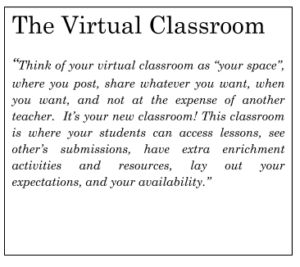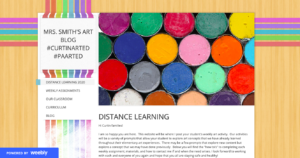May, 2020
now browsing by month
Virtual Classroom
Post written by Region 8 Representative, Jillette SmithHello artist-educators!
I originally planned on writing a blog that discussed using a blog space to engage your school community in and outside of the classroom. Although I am writing about just that, my dialogue has changed due to the new “normal” and the transition of being a visual arts classroom teacher to a virtual visual arts educator. Luckily, I have had experience with online learning previously, but that does not say that this was an easy transition. Many administrators and other teachers have not had these experiences and let’s face it; many of our public school districts do not have the technical capacity of an online educational institute. But, I have been a little inventive with what I have learned about online education to help me create a system that works for myself, my students, and their families. This article offers a reflection on how our role as an art educator has changed and explores virtual options to build, maintain, and advocate for a strong online, visual arts program.
Art educators problem solve, prepare lessons, teach curricula, advocate, and maintain our programs in order to enrich students to become independent thinkers who envision, create, and do. Although we are teaching in a new environment, it’s important to remember all of these roles are STILL very much the basis of what we need to do now. With a few modifications and a willingness to grow, we must throw out expectations of 100% class engagement, and forget about the idea of not being a “required to grade” so we can still be an integral teacher that, teaches, advocates and enriches students so that they can continue to flourish in the arts, academically, and just simply be well during the era of social distancing.
 Some days, I know it is hard to look past all the crazy things happening in the real world, but never doubt that we can determine how well we continue to do what we have already done since the beginning of September, and that is: show up and do our best. As we continue to “tread” these new waters’, we aren’t expected to get it right the first time around. Remember, across the state everywhere there is an elementary art teacher who has to email their lessons to a classroom teacher and hope that they get a few submissions in their email. If you are blessed to have a digital platform that gives you your own space such as Google Classroom, Blackboard, or Schoology, you may not feel this on the same level. But a great solution to this is to create or “build” yourself a virtual classroom. Think of your virtual classroom as “your space”, where you post, share whatever you want, when you want, and not at the expense of another teacher. It’s your new classroom! This classroom is where your students can access lessons, see other’s submissions, have extra enrichment activities and resources, lay out your expectations, and your availability. A blog can seem like a big task but it can be free and relatively simple. There are blog builders that are extremely user friendly through Google Sites, Weebly, and I am sure the list goes on if you do a web search.
Some days, I know it is hard to look past all the crazy things happening in the real world, but never doubt that we can determine how well we continue to do what we have already done since the beginning of September, and that is: show up and do our best. As we continue to “tread” these new waters’, we aren’t expected to get it right the first time around. Remember, across the state everywhere there is an elementary art teacher who has to email their lessons to a classroom teacher and hope that they get a few submissions in their email. If you are blessed to have a digital platform that gives you your own space such as Google Classroom, Blackboard, or Schoology, you may not feel this on the same level. But a great solution to this is to create or “build” yourself a virtual classroom. Think of your virtual classroom as “your space”, where you post, share whatever you want, when you want, and not at the expense of another teacher. It’s your new classroom! This classroom is where your students can access lessons, see other’s submissions, have extra enrichment activities and resources, lay out your expectations, and your availability. A blog can seem like a big task but it can be free and relatively simple. There are blog builders that are extremely user friendly through Google Sites, Weebly, and I am sure the list goes on if you do a web search.
To date, I do not have every student submitting each lesson, but I still want to show up and try to reach or “hook” more students from week to week. Here are a few things to remember with long-distance communication: to be clear with your availability, a good rule of thumb to respond to your families is 12 to 24 hours during the regular business week. Communication should not just end there, take the time to respond and give feedback to your submissions. Follow up with students or families who have asked questions to ensure that your students’ and families’ questions have been resolved. I wish that I had time to respond to all of my students’ work during the school year with 500+. This is a task that usually doesn’t happen, but I have more time to give to my students now because I don’t have a ton of prep work to do. Because we cannot help troubleshoot with our students, as they work, and when things go wrong so it is important to note that our feedback is where our CONNECTION will grow.
There are many things that we all are missing right now and I personally miss displaying students’ artwork. It was a large part of my week. Art displayed throughout the building always enhances school community engagement. It not only cultivates a warm environment for our students but it advocates every faculty member, every community member, and every administrator who enters our halls. So to make up for this, I created a page in my virtual classroom that showcases student work. To increase the likelihood of others seeing this I will email a link to students and families, I even include my school community! Usually, my message is short and sweet, like; “check out these awesome submissions! Click the link to see!”
As we continue this journey and gear up for a new year in the fall, I hope that you take away some positives from your end of the year reflections. But most importantly I hope you are safe, healthy, and well!
Resources:
https://www.edutopia.org/article/show-must-go-online-arts-teachers-adapt-home-instruction


 D5 Creation
D5 Creation